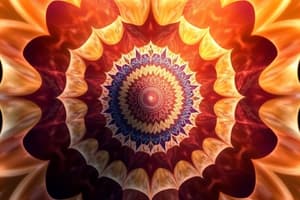Podcast
Questions and Answers
According to Stewart (1995), what is the primary function of mathematics?
According to Stewart (1995), what is the primary function of mathematics?
- To predict future events.
- To uncover and utilize underlying rules and structures in observed patterns. (correct)
- To create abstract models of the universe.
- To quantify natural phenomena.
Which of the following best describes mathematics, according to the content?
Which of the following best describes mathematics, according to the content?
- The study of indirect measurement.
- A collection of formulas and equations.
- The study of patterns and structures that helps us understand the world. (correct)
- A tool for calculating numerical values.
Where can mathematics be found, according to the material provided?
Where can mathematics be found, according to the material provided?
- In selective advanced scientific fields.
- Exclusively in academic textbooks and research papers.
- Only in man-made structures and technologies.
- In various patterns and occurrences in nature and our daily lives. (correct)
How does mathematics contribute to our understanding of the world?
How does mathematics contribute to our understanding of the world?
Leonardo Pisano Fibonacci is credited with introducing which of the following concepts to the world?
Leonardo Pisano Fibonacci is credited with introducing which of the following concepts to the world?
In the Fibonacci sequence, how is each number after the first two determined?
In the Fibonacci sequence, how is each number after the first two determined?
Which of the following is an example of where Fibonacci numbers can be observed in real life?
Which of the following is an example of where Fibonacci numbers can be observed in real life?
If f(n) represents a Fibonacci number, which formula accurately represents how to calculate it, where n > 1?
If f(n) represents a Fibonacci number, which formula accurately represents how to calculate it, where n > 1?
What value do you approach when taking the ratio of two successive numbers in the Fibonacci sequence?
What value do you approach when taking the ratio of two successive numbers in the Fibonacci sequence?
Which statement correctly describes the Golden Ratio?
Which statement correctly describes the Golden Ratio?
What is another name for the Golden Ratio?
What is another name for the Golden Ratio?
What is the approximate numerical value of the Golden Ratio?
What is the approximate numerical value of the Golden Ratio?
If a line segment of total length $'a + b'$ is divided according to the golden ratio, with 'a' being the longer segment, which equation holds true?
If a line segment of total length $'a + b'$ is divided according to the golden ratio, with 'a' being the longer segment, which equation holds true?
What distinguishes a Fibonacci poem (Fib) from other forms of poetry?
What distinguishes a Fibonacci poem (Fib) from other forms of poetry?
Who is credited with creating the Fibonacci poem form?
Who is credited with creating the Fibonacci poem form?
What is a 'fibonaiku'?
What is a 'fibonaiku'?
What is the syllable count per line for 6-line Fibonacci poem?
What is the syllable count per line for 6-line Fibonacci poem?
Which of the following is the most accurate definition of mathematics?
Which of the following is the most accurate definition of mathematics?
How does mathematics relate to nature?
How does mathematics relate to nature?
Which of the following is NOT explicitly mentioned as an objective of studying mathematics in this module?
Which of the following is NOT explicitly mentioned as an objective of studying mathematics in this module?
Considering the role of mathematics in predicting natural phenomena, which field benefits most directly from this application?
Considering the role of mathematics in predicting natural phenomena, which field benefits most directly from this application?
What concept, introduced by Fibonacci, facilitates efficient calculations and is widely used today?
What concept, introduced by Fibonacci, facilitates efficient calculations and is widely used today?
If a population of rabbits follows the Fibonacci sequence, starting with one pair, how many pairs will there be after 5 months, assuming each pair takes one month to mature and then produces a new pair each month?
If a population of rabbits follows the Fibonacci sequence, starting with one pair, how many pairs will there be after 5 months, assuming each pair takes one month to mature and then produces a new pair each month?
Given the Fibonacci sequence and its presence in various natural structures, which conclusion is most reasonable?
Given the Fibonacci sequence and its presence in various natural structures, which conclusion is most reasonable?
If a sunflower exhibits a spiral pattern based on Fibonacci numbers, and it has 55 spirals going clockwise, approximately how many spirals would you expect going counter-clockwise, assuming it follows the next Fibonacci number?
If a sunflower exhibits a spiral pattern based on Fibonacci numbers, and it has 55 spirals going clockwise, approximately how many spirals would you expect going counter-clockwise, assuming it follows the next Fibonacci number?
As you divide consecutive Fibonacci numbers (e.g., 3/2, 5/3, 8/5), the result approaches a specific value. Which artistic or architectural principle is most closely associated with this value?
As you divide consecutive Fibonacci numbers (e.g., 3/2, 5/3, 8/5), the result approaches a specific value. Which artistic or architectural principle is most closely associated with this value?
Considering the Golden Ratio's prevalence in aesthetics and natural forms, how might an artist deliberately use it to enhance their work?
Considering the Golden Ratio's prevalence in aesthetics and natural forms, how might an artist deliberately use it to enhance their work?
If a painting strictly adheres to the proportions defined by the Golden Ratio, what might be a potential critique of this approach?
If a painting strictly adheres to the proportions defined by the Golden Ratio, what might be a potential critique of this approach?
Given the definition of a Fibonacci poem, if the first two lines have 1 syllable each, and the third line has 2 syllables, how many syllables should the fourth, fifth, and sixth lines have, respectively?
Given the definition of a Fibonacci poem, if the first two lines have 1 syllable each, and the third line has 2 syllables, how many syllables should the fourth, fifth, and sixth lines have, respectively?
How does the structure of a Fibonacci poem reflect the mathematical concepts it's based on?
How does the structure of a Fibonacci poem reflect the mathematical concepts it's based on?
Considering that Fibonacci poems and the Golden Ratio both stem from the Fibonacci sequence, what might this suggest about the relationship between mathematics and art?
Considering that Fibonacci poems and the Golden Ratio both stem from the Fibonacci sequence, what might this suggest about the relationship between mathematics and art?
Given a six-line Fibonacci poem, if the third line contains the word 'ocean,' what could the first and second lines be?
Given a six-line Fibonacci poem, if the third line contains the word 'ocean,' what could the first and second lines be?
Which of the following values is closest to what is know as Phi?
Which of the following values is closest to what is know as Phi?
How are patterns and regularity connected to mathematics?
How are patterns and regularity connected to mathematics?
How is math related to prediction?
How is math related to prediction?
What did Isacc Asimov say about mathematics?
What did Isacc Asimov say about mathematics?
How are the number of petals on a flower related to mathematics?
How are the number of petals on a flower related to mathematics?
How can mathematics be useful?
How can mathematics be useful?
How did the Egyptians view the golden ratio?
How did the Egyptians view the golden ratio?
When analyzing the navel position of individuals, which result is the most likely when determining the ratio?
When analyzing the navel position of individuals, which result is the most likely when determining the ratio?
Flashcards
What is Mathematics?
What is Mathematics?
Mathematics is a systematic approach to understanding patterns and regularity in the world through rules and structures.
Math according to Aristotle
Math according to Aristotle
Mathematics is the science of quantity.
Math according to Comte
Math according to Comte
Mathematics is the science of indirect measurement.
Math according to Pierce
Math according to Pierce
Signup and view all the flashcards
Role of Mathematics
Role of Mathematics
Signup and view all the flashcards
Fibonacci Numbers
Fibonacci Numbers
Signup and view all the flashcards
Golden Ratio
Golden Ratio
Signup and view all the flashcards
What is the Golden Ratio?
What is the Golden Ratio?
Signup and view all the flashcards
Fibonacci Poem (FIB)
Fibonacci Poem (FIB)
Signup and view all the flashcards
Typical Fib structure
Typical Fib structure
Signup and view all the flashcards
Study Notes
- The slides present module 1 which includes topics on "Mathematics in our World" and "Fibonacci Numbers".
- The objectives are to identify patterns and regularities in nature and the world, articulate the importance of mathematics in one's life, and express appreciation for mathematics as a human endeavor.
What Is Mathematics?
- According to Stewart (1995), mathematics is a systematic approach of discovering the rules and structures behind observed patterns or regularities.
- It utilizes these rules and structures to provide explanations
- Aristotle defines mathematics as the science of quantity.
- Comte defines it as the science of indirect measurement.
- Benjamin Pierce describes mathematics as the science that draws necessary conclusions
- The study of pattern and structure.
- A useful way to understand nature and the world.
- A tool to quantify, organize, control the world, predict phenomena, and improve life.
Where Is Mathematics?
- Found in many patterns and occurrences in nature, the world, and life.
- Mathematics helps give sense to these patterns and occurrences.
- Mathematics helps organize patterns and regularities in the world
- Mathematics helps predict the behavior of nature and phenomena in the world.
- Examples of where mathematics can be found are images of the stars shown on the 11th slide, snowflakes from the 12th slide, and animal patterns from the 13th slide.
- It is mathematically possible to describe nature.
- The beauty of a flower, a tree, and even rock formations exhibit nature's sense of symmetry.
- Paul Dirac stated that "God used beautiful mathematics in creating the world."
Fibonacci Numbers
- Leonardo Pisano Fibonacci, also Leonardo of Pisa, was an Italian mathematician who introduced the world to Arabic numbering (now known), square roots, number sequencing, and math word problems.
- In 1202, Fibonacci proposed a puzzle about a man who put a male-female pair of newly born rabbits in a field.
- The questions posed was how many rabbit pairs would be there after one year
Fibonacci Numbers in Real Life
- Petal arrangements in flowers
- Bees constructing honeycombs
- Tree branches
- Shell structures
- Pinecones
- Financial markets
- Pascal's Triangle
- Paintings
- Fibonacci numbers are numbers in the Fibonacci sequence.
- Every number after the first two is the sum of the two preceding ones.
What is the Golden Ratio?
- Taking the ratio of two successive numbers in Fibonacci's series tends to approach a specific value.
- The golden ratio is the ratio of a line segment cut into two pieces of different lengths.
- The ratio of the whole segment to the longer segment equals the ratio of the longer segment to the shorter segment.
- The golden ratio is also called the Divine Proportion
- The golden ratio is sometimes known as the golden mean or golden section.
- The Egyptians referred to it as the "sacred ratio."
- The golden ratio is denoted by Phi (Φ) or φ.
- The golden ratio is approximately equal to 1.6180339887
Fibonacci Poem (FIB)
- Goal is to collaborate with a partner to write a six-line FIB and express appreciation of Fibonacci numbers as applied in poetry.
- A Fibonacci poem is a form of poetry where the number of syllables in each line must equal to the sum of the syllables in the two previous lines
- Gregory K. Pincus created this form of poetry that plays off the mathematical Fibonacci sequence.
- Fib, or fibonaiku, is an experimental Western poetry form bearing similarities to haiku but based on the Fibonacci sequence.
- A typical fib is a six-line, 20-syllable poem with a syllable count by line of 1/1/2/3/5/8.
Syllables for Six-Line Poem
- 1 syllable for the first line
- 1 syllable for the second line
- 2 syllables for the third
- 3 syllables for the fourth
- 5 syllables for the fifth
- 8 syllables for the sixth
Studying That Suits You
Use AI to generate personalized quizzes and flashcards to suit your learning preferences.




